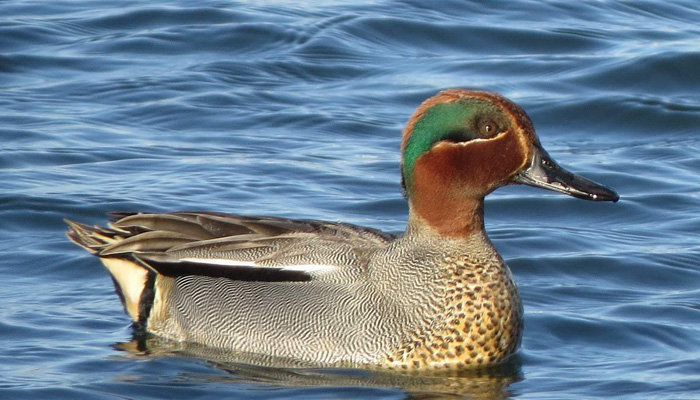
English: Eurasian Teal,
Green-winged Teal
Russian: Чирок-свистунок
German: Krickente
French: Sarcelle
d’hiver
Mongolian: Ногоохон нугас
Japanese: コガモ (Ko-gamo)
Body Length: 34-38 cm
Wing span: 53-59 cm
Breeding visitor
Breeding season: May-August
Egg number: 8-12
Egg color: Pale creamy white
Brood: 1 per year
Global status: Least concern
Regional status: Least Concern
Habitat: Breeds
on variety of fresh and brackish waters, preferring lakes and ponds (even quite
small ones) in forests, pools in taiga bogs or mountain willows, also along
rivers and shallow, well-vegetated seashores, and on eutrophic, lakes if near
forests, where nest is placed. A common bird, forming large flocks on coastal
bays or shallow lakes outside breeding season. Birds from N Europe winter in
Britain, but also in Holland, France, etc.
Identification:
Smallest duck, with narrow, pointed wings, short neck, fast and agile flight
and dense flock formation; takes off from water easily and rises steeply, will
twist and turn readily in flight. At distance in flight, appears dark with
short, broad white bar along centre of upperwing (both sexes). Speculum glossy
green.
- Adult
♂ breeding: Head chestnut with green sides, green colour thinly bordered
yellow. Sides of undertail pale yellow, bordered black, visible even at
distance. Horizontal white line along grey body. Told from N American
Green-winged Teal by this horizontal white line (Green –winged has vertical band
across breast-side), and by complete thin yellow lines on sides of head.
- Adult
♀: Brown, streaked and mottled dark. Swimming bird resembles Garganey, but
note: small size; small bill, often a little orange at base; moderately dark
eye-stripe and lack of dark stripe over cheeks make head look fairly plain; a
pale patch or streak along base of tail-side; chin/throat not so clean and pale
buff-white. In flight told by wing pattern; belly diffusely paler at centre;
underwing has whitish centre and dark leading and trailing edges.
- Eclipse
♂ and juvenile very similar to adult ♀, juveniles generally slightly darker
(also on belly), and flanks more ‘striped’ dark (adult ♀ has more delicate
scaly pattern).
Food:
Green Plants in wet meadows and invertebrates.